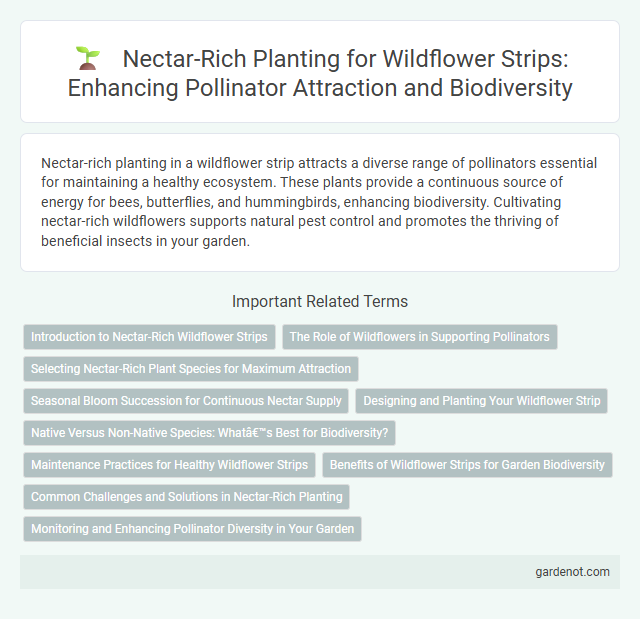Nectar-rich planting in a wildflower strip attracts a diverse range of pollinators essential for maintaining a healthy ecosystem. These plants provide a continuous source of energy for bees, butterflies, and hummingbirds, enhancing biodiversity. Cultivating nectar-rich wildflowers supports natural pest control and promotes the thriving of beneficial insects in your garden.
Introduction to Nectar-Rich Wildflower Strips
Nectar-rich wildflower strips are essential habitats designed to support pollinators such as bees, butterflies, and hummingbirds by providing abundant sources of nectar throughout the growing season. These strips typically include diverse native flowering plants like coneflowers, milkweed, and black-eyed Susans, promoting ecological balance and enhancing biodiversity. Implementing nectar-rich wildflower strips improves pollination services for nearby crops and strengthens ecosystem resilience.
The Role of Wildflowers in Supporting Pollinators
Wildflower strips provide essential nectar-rich planting that supports diverse pollinators such as bees, butterflies, and hummingbirds by offering a continuous floral resource throughout the growing season. These strips increase pollinator habitat connectivity, essential for sustaining healthy pollinator populations and enhancing crop pollination efficiency. Incorporating native wildflower species maximizes nectar availability and encourages pollinator diversity, contributing significantly to ecosystem resilience and agricultural productivity.
Selecting Nectar-Rich Plant Species for Maximum Attraction
Selecting nectar-rich plant species such as milkweed, coneflowers, and bee balm maximizes pollinator attraction in wildflower strips. These plants provide high-energy nectar essential for butterflies, bees, and hummingbirds, enhancing biodiversity and supporting ecosystem health. Incorporating a variety of bloom times ensures continuous nectar availability throughout the growing season.
Seasonal Bloom Succession for Continuous Nectar Supply
Wildflower strips designed with nectar-rich plants ensure continuous nectar supply through seasonal bloom succession, supporting pollinators from early spring to late autumn. Incorporating species such as crocus, lavender, and goldenrod creates a sequence of overlapping flowering periods that sustain bees, butterflies, and other beneficial insects throughout the year. This strategic planting enhances biodiversity and stabilizes ecosystem services vital for agriculture and natural habitats.
Designing and Planting Your Wildflower Strip
Designing your wildflower strip with nectar-rich plants such as Echinacea, Liatris, and Asclepias attracts diverse pollinators like bees and butterflies, enhancing local biodiversity. Selecting species with staggered bloom times ensures continuous nectar supply throughout the growing season, supporting pollinator health and ecosystem function. Proper soil preparation and planting density optimize growth and nectar availability, resulting in a vibrant, sustainable wildflower habitat.
Native Versus Non-Native Species: What’s Best for Biodiversity?
Nectar-rich planting in wildflower strips significantly boosts local biodiversity by supporting pollinators such as bees and butterflies. Native species offer co-evolved benefits, providing optimal nectar quality and habitat for indigenous insects, while non-native species may contribute additional nectar sources but risk disrupting local ecosystems. Prioritizing a diverse mix dominated by native plants enhances ecosystem resilience and promotes sustainable biodiversity in wildflower strips.
Maintenance Practices for Healthy Wildflower Strips
Regularly monitoring soil moisture and removing invasive weeds ensures optimal growth and prolonged blooming of nectar-rich wildflower strips. Mowing late in the season, after seed set, supports plant regeneration and encourages diverse pollinator habitats. Applying minimal or no herbicides preserves native flora and maintains the ecological balance vital for healthy wildflower ecosystems.
Benefits of Wildflower Strips for Garden Biodiversity
Wildflower strips provide nectar-rich planting essential for supporting pollinators like bees and butterflies, enhancing garden biodiversity by attracting a variety of beneficial insects. These strips improve ecosystem health through natural pest control and promote the survival of native flora and fauna. Increased insect diversity from wildflower strips also boosts pollination rates, leading to more resilient and productive garden environments.
Common Challenges and Solutions in Nectar-Rich Planting
Nectar-rich planting often faces challenges such as soil nutrient imbalance, pests, and limited pollinator visits. Addressing these issues requires selecting native, drought-tolerant wildflower species to enhance resilience and establishing diverse plant communities to attract a broad range of pollinators. Implementing integrated pest management and optimizing soil conditions with organic matter improves plant health and nectar production.
Monitoring and Enhancing Pollinator Diversity in Your Garden
Nectar-rich planting in wildflower strips supports a diverse range of pollinators by providing continuous floral resources throughout the growing season. Monitoring pollinator visits through regular observation and identification helps track species diversity and abundance, informing adaptive management practices. Enhancing pollinator diversity involves incorporating a variety of native wildflowers with staggered bloom times and maintaining habitat features such as nesting sites and undisturbed soil patches.
Nectar-rich planting Infographic

 gardenot.com
gardenot.com